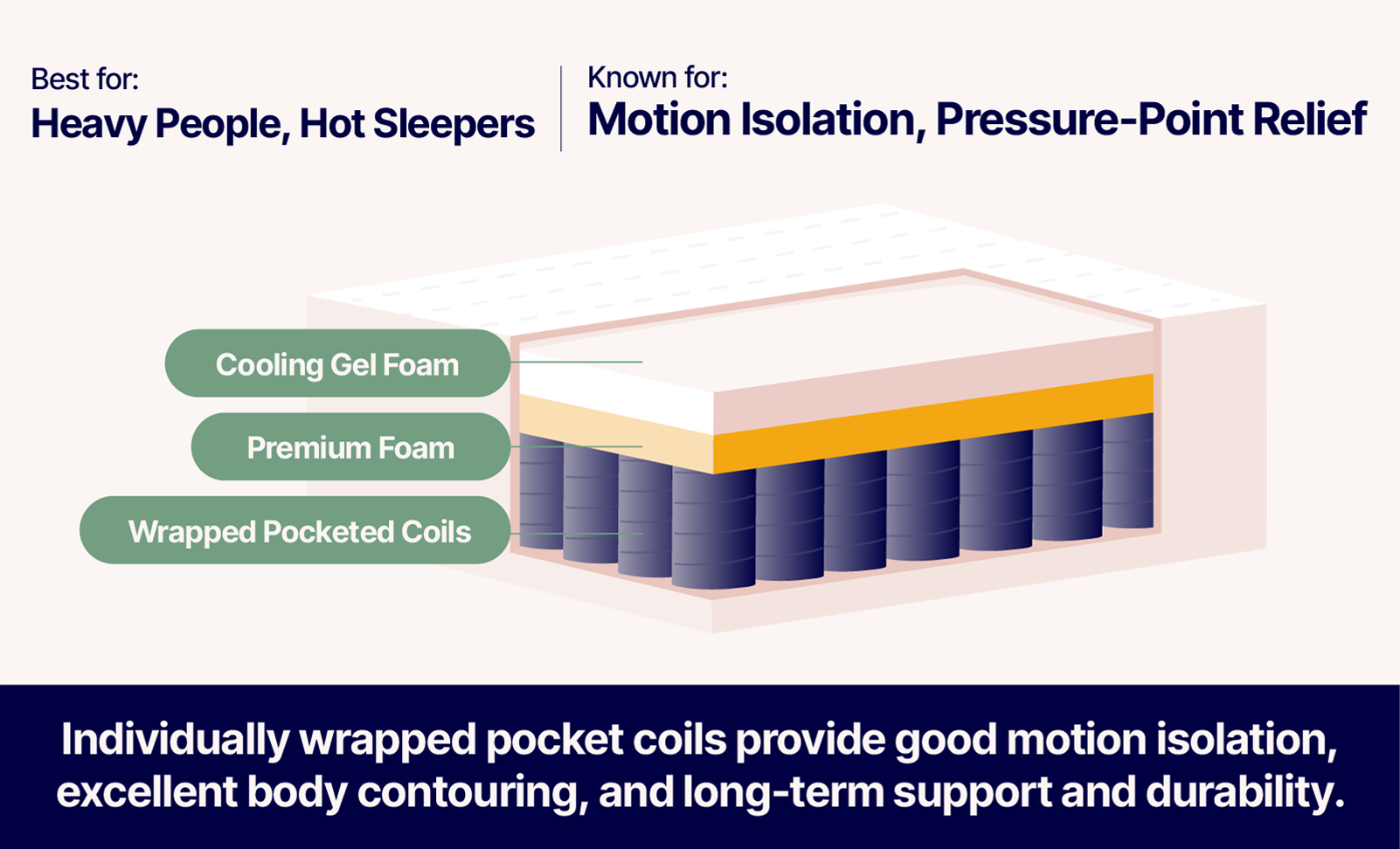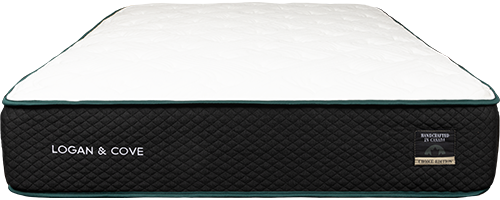Pocket Coil vs Innerspring: Which Is Right For You? (2025)
Updated: December 1, 2025 | Published: September 30, 2024Mattresses with inner coils have been around for a long time. There are many different varieties, with some being exposed and others wrapped in fabric. It may not seem like a big difference, but the type of coil can affect your sleep quality.
- Innerspring (or spring) mattresses have a thin layer of foam above large metal coils, which give them a firm feel and excellent edge support.
- Pocket coils are very similar to innersprings, but the coils are wrapped in fabric. They tend to have better pressure-point relief and motion isolation compared to regular innersprings, and are often found in hybrid mattresses.
In this article, we’ll take a closer look at innerspring vs pocket coil mattresses. We’ll show you how they’re constructed, compare their pros and cons, and help you find out which type of mattress works best for you.
Breakdown: Pocket Coil vs Innerspring Mattress
Category | Pocket Coil Mattresses | Innerspring Mattresses |
|---|---|---|
Cost | $1,000–3,000+ | $250–2,500+ |
Feel | Balanced and supportive feel that stops you from sinking too deeply into the mattress | Firmer, more supportive feel that stops you from sinking too deeply into the mattress |
Advantages | Better for a wide range of sleep styles Better motion isolation, body contouring, and pressure-point relief | Often less expensive than pocket coil mattresses Bouncy surface makes it easy to change positions |
Disadvantages | Can be much pricier than traditional innerspring designs
| Less motion isolation than pocket coil mattresses
|
Best for… | Those who tend to sleep warm
| Budget shoppers looking for a long-lasting mattress
|
What is a pocket coil mattress?
Pocket coil mattresses use steel innersprings individually wrapped in fabric, making them quieter, better at isolating motion, and giving the mattress better airflow. Today, they’re most often found in hybrid mattress designs, which feature a layer of pocketed coils underneath one or more layers of foam.
Pocket coils have many advantages when compared to traditional innerspring mattresses. They’re quieter and more effective at reducing motion transfer, making them ideal for light sleepers who are easily disturbed by movement. They also have a balanced feel that’s somewhat less firm than traditional innersprings, making them suitable for a wider range of sleep styles.
Mattresses with pocketed coils also often feature “zoned support” systems. This means that coils with different gauges (thickness) can be built into different areas of the support layer, giving your body more support underneath your hips and lower back, but less at your shoulders and feet. The result is more contoured support while you’re lying down, maintaining the natural curve of your spine and preventing pressure points.

Logan & Cove Choice, our top pick for the best pocket coil mattress, is an excellent example. It features layers of ecoLuxe® cooling gel foam and breathable, responsive Elastex® foam above a 9″ layer of individually pocketed coils. These coils are divided into three body-supporting zones to give contouring support for your back and hips.
Pocket Coil Mattress Pros & Cons
Pros | Cons |
|---|---|
|
|
What is an innerspring mattress?
Innerspring mattresses use metal coils to support you while you sleep, and typically only have a very thin layer of foam on top. There may also be a foam layer underneath the coil layer to insulate the mattress from the bedframe.
Innerspring mattresses tend to be firmer than pocket coil mattresses. They have excellent edge support and are excellent for back sleepers, as well as heavy sleepers.
However, innerspring mattresses come with a few disadvantages. They can be noisy to sleep on, have less motion isolation than pocketed coils, and can put more strain on your body’s pressure points. Let’s go over the type of coils you’re likely to find in an innerspring mattress:
- Bonnell coils are shaped like an hourglass and usually wired together to form a single unit. They’re less durable, supportive, and motion-isolating than other coil types.
- Offset coils are interconnected like Bonnell coils but not as rounded, and they have better motion isolation and support.
- Continuous coils are rows of circular connected wires. They’re durable, but they don’t provide good motion isolation, are less comfortable to sleep on, and are fairly noisy.
- Micro coils are similar to (and often paired with) pocket coils, but much smaller. This type of coil is typically found above the support layer, providing added contouring and responsiveness.

Spa Sensations is an example of an innerspring mattress. It combines coils with relatively thin layers of foam on top. Like many innerspring designs, it’s extremely bouncy with a firm feel and also has good edge support. However, as a budget mattress, it lacks many useful features, like advanced cooling technologies, a sleep trial, and a free bedding bundle.
In comparison, Logan & Cove has a cooling nanofibre cover and cooling gel foam. Featuring a 365-night sleep trial and 15-year warranty, it also comes with a free bedding bundle that includes a mattress protector, sheets, pillow(s), and pillow protector(s).
Innerspring Mattress Pros & Cons
Pros | Cons |
|---|---|
|
|
FAQ
What is the difference between an innerspring and a pocket coil mattress?
While both types of mattresses use coils in their construction, the coils in pocket coil mattresses are typically wrapped in fabric, while the coils in an innerspring mattress are not. Pocket coils are a modern innerspring that offers better motion isolation and noise reduction from the coils compared to traditional innersprings. They’re often found in popular hybrid mattress brands such as Logan & Cove.
What are pocketed coils?
Pocketed coils are innersprings that are wrapped in fabric. This design makes them quieter than traditional innersprings. Pocketed coils also have superior motion isolation and are quieter to sleep on.
How many pocket coils should a mattress have?
A mattress should have as many coils as it takes to give you a supportive, restful sleep. Mattresses with more coils often have separate zones of support to better contour your body while you’re lying down. Logan & Cove Choice, for instance, features more than 900 coils (in a queen size) divided across three areas of the mattress.
Can you flip a pocket coil mattress?
That depends on how the mattress is constructed. Pocket coils are often found in hybrid mattress designs, which are not designed to be flipped. It may be possible to flip a mattress if its interior is composed mostly or entirely of pocket coils. We recommend checking with the manufacturer before doing so to be safe.
Is an innerspring mattress good for back pain?
Innerspring mattresses are very responsive and generally firmer than other mattress types, which can be good if you have back pain related to a lack of back support while sleeping. However, a mattress that is too firm for your body type and sleep style can also cause back pain, or worsen existing back pain.
READ MORE: What’s the best mattress for back pain?
Do innerspring mattresses need a box spring?
That depends on how the mattress is constructed. Modern innerspring mattresses can often be used with different mattress foundations, while traditional innersprings tend to work best (and last longer) when used with a box spring. Always check with the manufacturer to see whether your mattress is compatible with a box spring, and be sure to use the type of foundation they recommend.
Our goal is to provide the information you need to find the mattress that’s right for you. Get started with some of our most popular mattress shopping resources:
- Best Mattress Guides: Best Mattress Canada, Best Mattress In a Box
- Reviews: Douglas Original, Logan & Cove Choice, Juno, Octave Vista
- Comparisons: Douglas vs Endy, Douglas vs Casper
We use independent, third-party engineering firms (commissioned by us) with the APEGA stamp of approval to conduct mattress testing on our behalf, using publicly available data. We review and test all mattresses on 40+ criteria we think are important to you, including price, country of manufacture, sleep trial, warranty, features, materials used, motion isolation and edge support ratings, customer satisfaction reviews, returns, and refunds.
